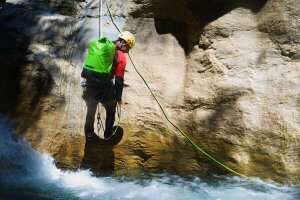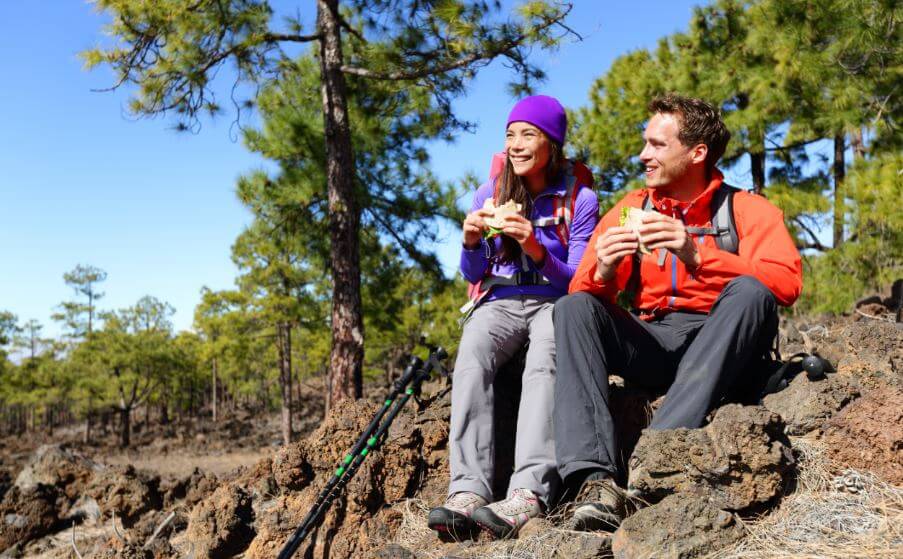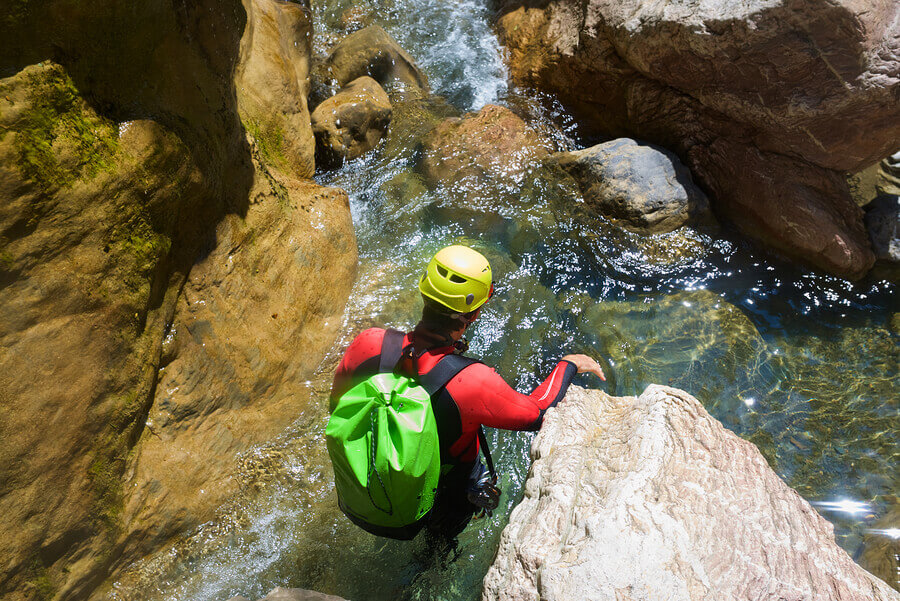Discover Canyoning: A Full Body Workout in Nature

If you like to exercise surrounded by nature, canyoning is an outdoor sport that lets you reap the benefits of exercise while enjoying the incredible scenery.
Among other things, canyoning is an extreme sport that consists of following a course along a river, gorge or narrow canyon. It combines equal parts of adrenaline and the beauty of nature.
Walking along the gorges, waterfalls, and boulders, following your route is the path into nature. It also opens the doors to the great benefits of exercising outdoors.
Canyoning combines elements of various outdoor sports, such as rappelling or swimming. In addition, it also requires certain knowledge and skills for safely setting up ropes.
You only need to know how to swim and a healthy cardiovascular system to start canyoning as well as the appropriate equipment for a safe route. If you’re just starting off, don’t worry: you can adapt canyoning for any level.
But canyoning isn’t free from risks
Despite all the precautions you may follow, canyoning can still be a dangerous sport. In light of that, you have to take some things into considerations before heading out.
First off, don’t forget that in canyoning, you’ll be moving around humid areas. Thus, warm temperatures and moderate levels of water make the best conditions. May through September is usually the best time period to go canyoning.

Joining an organized group is the best way to start your adventure. In a group, you can learn the basic techniques, receive safety tips and familiarize yourself with the needed equipment.
Canyoning boasts great benefits such as a good cardiovascular workout and passing time in nature.
What do you need to start?
Having the right equipment will help make your trips safer and easier. There are many pieces that can come in handy depending on the difficulty of the descent. But there are a handful of essential elements that are appropriate for any adventure:
1. Helmet
Canyoning implies risks of injury so a helmet is an essential form of protection. Make sure you choose a waterproof model that fits comfortably.
2. Rope
Even if you’re not planning on doing a tricky descent, a good climbing rope always comes in handy. Among other uses, a good rope can help other members in your group who have a hard time lowering into deeper sections of the course. In extreme cases, a rope can also help in a rescue.
3. Wetsuit
You’ll get soaked during your explorations. A wetsuit can be an essential piece to protect you from the color when entering or exiting the water. It’ll keep you warm enough to continue your route.
4. Gloves
A pair of tough gloves will keep your hands safe and healthy throughout your adventure. They’ll also help you get a better grip on complicated surfaces.

5. Appropriate footwear: canyoning must
Last but not least, you’ll also need a pair of comfortable yet tough shoes that have a great grip to get you through the watery paths.
Always remember that canyoning is a demanding sport that requires a certain level of physical condition. However, courses can vary in difficulty levels, so anyone can find one that suits them. The amount of water and obstacles in the courses determines the level of difficulty.
Furthermore, just like any other extreme sport, canyoning has its share of risks. If you lack the experience or know-how, your risks of danger can increase.
On a similar note, before you step up to the challenge, make sure that you have all of the necessary equipment and skill-sets. If you want to try a solo trip, make sure you have the training to back you up. You won’t regret it!
If you like to exercise surrounded by nature, canyoning is an outdoor sport that lets you reap the benefits of exercise while enjoying the incredible scenery.
Among other things, canyoning is an extreme sport that consists of following a course along a river, gorge or narrow canyon. It combines equal parts of adrenaline and the beauty of nature.
Walking along the gorges, waterfalls, and boulders, following your route is the path into nature. It also opens the doors to the great benefits of exercising outdoors.
Canyoning combines elements of various outdoor sports, such as rappelling or swimming. In addition, it also requires certain knowledge and skills for safely setting up ropes.
You only need to know how to swim and a healthy cardiovascular system to start canyoning as well as the appropriate equipment for a safe route. If you’re just starting off, don’t worry: you can adapt canyoning for any level.
But canyoning isn’t free from risks
Despite all the precautions you may follow, canyoning can still be a dangerous sport. In light of that, you have to take some things into considerations before heading out.
First off, don’t forget that in canyoning, you’ll be moving around humid areas. Thus, warm temperatures and moderate levels of water make the best conditions. May through September is usually the best time period to go canyoning.

Joining an organized group is the best way to start your adventure. In a group, you can learn the basic techniques, receive safety tips and familiarize yourself with the needed equipment.
Canyoning boasts great benefits such as a good cardiovascular workout and passing time in nature.
What do you need to start?
Having the right equipment will help make your trips safer and easier. There are many pieces that can come in handy depending on the difficulty of the descent. But there are a handful of essential elements that are appropriate for any adventure:
1. Helmet
Canyoning implies risks of injury so a helmet is an essential form of protection. Make sure you choose a waterproof model that fits comfortably.
2. Rope
Even if you’re not planning on doing a tricky descent, a good climbing rope always comes in handy. Among other uses, a good rope can help other members in your group who have a hard time lowering into deeper sections of the course. In extreme cases, a rope can also help in a rescue.
3. Wetsuit
You’ll get soaked during your explorations. A wetsuit can be an essential piece to protect you from the color when entering or exiting the water. It’ll keep you warm enough to continue your route.
4. Gloves
A pair of tough gloves will keep your hands safe and healthy throughout your adventure. They’ll also help you get a better grip on complicated surfaces.

5. Appropriate footwear: canyoning must
Last but not least, you’ll also need a pair of comfortable yet tough shoes that have a great grip to get you through the watery paths.
Always remember that canyoning is a demanding sport that requires a certain level of physical condition. However, courses can vary in difficulty levels, so anyone can find one that suits them. The amount of water and obstacles in the courses determines the level of difficulty.
Furthermore, just like any other extreme sport, canyoning has its share of risks. If you lack the experience or know-how, your risks of danger can increase.
On a similar note, before you step up to the challenge, make sure that you have all of the necessary equipment and skill-sets. If you want to try a solo trip, make sure you have the training to back you up. You won’t regret it!
All cited sources were thoroughly reviewed by our team to ensure their quality, reliability, currency, and validity. The bibliography of this article was considered reliable and of academic or scientific accuracy.
- Hardiman, N., & Burgin, S. (2011). Canyoning adventure recreation in the Blue Mountains World Heritage Area (Australia): The canyoners and canyoning trends over the last decade. Tourism Management, 32(6), 1324–1331. https://doi.org/10.1016/j.tourman.2011.01.002
- Brandão, A., Pereira, J., Gonçalves, F., Coelho, E., & Quaresma, L. (2018). Risks in adventure sport activity. Which risks are perceived by experienced canyoneers? Journal of Physical Education and Sport, 18(1), 163–169. https://doi.org/10.7752/jpes.2018.01021
This text is provided for informational purposes only and does not replace consultation with a professional. If in doubt, consult your specialist.








